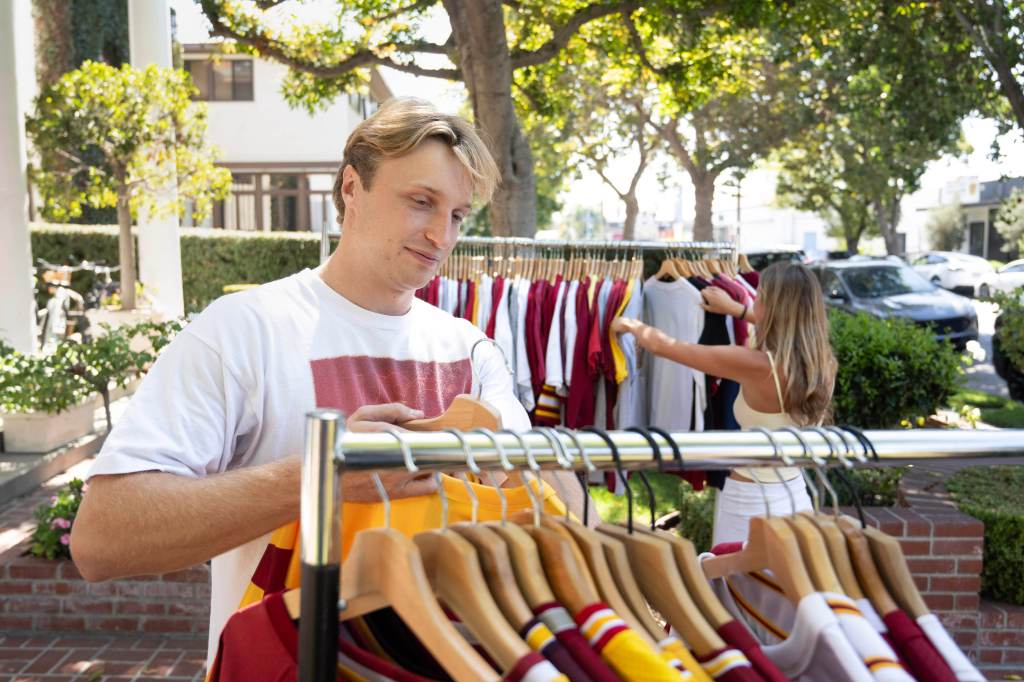LOS ANGELES — The Delta Gamma sorority house was bustling on a warm, sunny Friday afternoon. Sisters flit in and out of the house while others gab about the new semester, sipping on iced coffees that are quickly gathering condensation.
Very few pass by without sifting through the racks of gold and cardinal that saturate the house’s lawn. It’s a pop-up event by Sideline Closet, a USC vintage clothing seller, and its reach is going far beyond the well-manicured lawns of Greek Row.
“This ain’t gear that you get and wear one time and get rid of it,” USC football cornerbacks coach Trovon Reed said. “This is gear that you keep for life.”
From hobby to hustle
Jack Engstrom, the owner of Sideline Closet, started selling vintage clothing 10 years ago — back when it was a “nerdy hobby,” as he calls it.
“No one knew what it was,” Engstrom said. “It was kind of weird. Like, you want old clothes? But there were people who had been doing it for a while. They were all nerdy, collector types, and then it kind of started taking off into the mainstream.”
His friends within the industry carved out their own niches in the vintage fashion world, some rising to own brick-and-mortar stores. Those who didn’t find a specific brand simply didn’t last.
Engstrom landed on the USC theme because of a deeply felt connection to the school. He’s a Class of 2023 USC grad and a third-generation Trojan. Now, he’s lugging vintage clothing all around campus and selling out of his home, as well.
Former and current USC athletes have bought from him and some celebrities have dabbled. His clothing was even featured in a 2022 USC football social media campaign that featured quarterback Caleb Williams and linebacker Shane Lee.
“I feel a connection to it all, really,” former USC and NFL receiver Marqise Lee said in a message to Engstrom. “If I had to choose some (favorite) pieces, it would be the ones from the past. Them clothes show the beginning and it gives you a feeling you can’t really explain.”
Preserving history
Pete Carroll-era coach polos and baggy jerseys are popular men’s clothing choices right now, while women tend to go for baby tees, crewneck sweatshirts and form-fitting jerseys. But Engstrom’s inventory goes far deeper than that.
He’s got 1936 team-issued track sweaters and a two-piece track suit that Louis Zamperini wore in the 1936 Summer Olympics, which were held in Berlin under Nazi Germany. There’s a video of Zamperini meeting Adolf Hitler in it.
There’s a 1937 rat cap — a small, short-brimmed hat worn by technology students — that he found in France and bootleg T-shirts sold in parking lots during 1980s football games.
“‘True vintage’ is what we consider 50 years or older,” Engstrom said. “The true vintage stuff I keep at my place. I used to sell it, and now it’s just becoming so hard to find that I’m kind of preserving it.”
Even clothing from the 80s and 90s has historical appeal for buyers, and the quality is much better than what’s available nowadays in many cases.
Take Engstrom’s parking-lot-bootleg tee from the 1993 Freedom Bowl between USC and Utah, for example. Five different colors of ink were used to create the graphic and printed on a soft, 100% cotton shirt that was made in the USA. The shirts that are hawked outside the Coliseum today are much more hastily made.
Clothing retailers have begun to sell pseudo-vintage clothing with old school graphics, worn fabrics and hand-frayed seams en masse. Uniqueness and individuality are what set vintage clothing apart from factory-made counterparts.
“Everything I got from him is next-level,” Reed said. “There’s some dope stuff that you’re not just going to find walking the streets. Like, you’re not going to walk into a mall and see it. There’s some real vintage stuff that’s really really old and still clean that I get to wear every day.”
The future of vintage
Although many buyers are familiar with vintage clothing, Engstrom often finds himself explaining the history and meaning behind what he sells.
“I still get so many people who are like, ‘Oh my God, is that used? You sell the old shirts?’ And I’m like ‘Yeah, it’s the actual old shirt,’” he said. “There’s all these people who have no clue about it. With that amount of feedback I’m getting still, I can see so much more growth potential.”
New shoppers are being brought into the fold not just out of curiosity, but also out of a desire to support a local business or take part in a micro-economy that’s in their own backyard.
Engstrom is in the heart of his busy season, with football fans stocking up on outfits for game days and tailgates. He’ll continue to do weekly pop-up events until Christmas while offering private shopping experiences from his personal collection and selling from the Sideline Closet Instagram account.
A storefront is desirable but not feasible due to the high rent in Los Angeles and the seasonal nature of his sales. New customers are steadily flowing in, and he has enthusiasts like former Republic Records and Epic Records president Charlie Walk, who buys for his kids.
All are keeping USC’s rich tradition alive and flowing through Southern California.
“When you put on one of these pieces, you’re carrying forward the spirit of Trojans who came before you,” Walk said in a message to Engstrom.
“For me, as a parent, it’s incredible to see my kids literally wear that legacy — it’s pride, connection, and memory all stitched into one garment. And as someone who appreciates one-of-a-kind pieces, I see Sideline Closet as more than a brand. They’re preserving culture and passing it on, giving us a way to live USC history every single day.”












